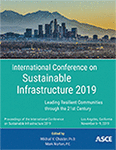International Conference on Sustainable Infrastructure 2019
Breaking Down Silos: Trends in Resilient and Sustainable Infrastructure Planning
Publication: International Conference on Sustainable Infrastructure 2019: Leading Resilient Communities through the 21st Century
ABSTRACT
Infrastructure faces a growing range of vulnerabilities as climate-change threats become more severe and global resources are increasingly constrained. Mirroring a typical pattern in addressing large-scale performance gaps within complex organizational structures, infrastructure owners have sought to identify, or create, tools and resources to pilot test solutions. Leveraging infrastructure rating systems has helped users understand the depth and breadth of what defines sustainability and resilience, identify the broad range of players, and highlight performance gaps. Following a successful pilot test, many organizations seek to standardize an approach across all projects and programs, developing sustainable design guidelines, often using the guidance and metrics of various rating systems. Like many organization-wide initiatives, identifying problems and growth areas for infrastructure is clear but owners cannot always fund the significant capital needed to implement the changes. However, as with many emerging technologies, as understanding of the fundamentals increases across an organization, so does the understanding of the interconnectedness of sustainability and resilience with existing resources and initiatives. This paper explores the benefits of these connections, and how they lead practitioners to logically tie sustainability and resilience initiatives with well-established principles and tools, like those provided by the asset management and information management disciplines. Equipped with a holistic approach that balances the needs of each of these spheres, an organization can set well-informed priorities and demonstrate data-verified performance in achieving these priorities to stakeholders and investors. The synthesis of these ideas can start to erode the existing financial barriers inhibiting expansion of sustainable and resilient infrastructure.
Get full access to this chapter
View all available purchase options and get full access to this chapter.
REFERENCES
Bloomfield, Priscilla, et al. (2013) “An Integrated Approach to Asset Management and Sustainability to Achieve Best Management Practices Through a Triple Bottom Line Approach.” Jacobs.
Bocchini, P., Frangopol, D. M., Ummenhofer, T., & Zinke, T. (2012). “Resilience and Sustainability of Civil Infrastructure: Toward a Unified Approach.” Journal of Infrastructure Systems, 20(2).
Bradford, E.J., M. Sarullo, C. Zammit. (2017). “Integrating Envision Principles in Program Management for Decision Support.” Paper presented at the 2017 International Conference for Sustainable Infrastructure, Los Angeles, California.
CEEQUAL. (2018, October 24). Retrieved from http://www.ceequal.com/. (Jan. 21, 2019).
Greenroads. “Greenroads Rating System”. Retrieved from https://www.greenroads.org/3738/about.html(Jan. 21, 2019).
Green City Bonds. (2016). “The Green Muni Bonds Playbook”. Retrieved from https://www.nrdc.org/resources/how-issue-green-muni-bond-green-muni-bonds-playbook (Jan. 21, 2019).
Griffiths, Kerry, et al. “Beyond the Certification Badge—How Infrastructure Sustainability Rating Tools Impact on Individual, Organizational, and Industry Practice.” Sustainability, vol. 10, no. 4, 2018, p. 1038.
Institute of Asset Management. Asset Management – an Anatomy. vol. 3, 2015.
Institute for Sustainable Infrastructure. “About ISI”. Retrieved from https://sustainableinfrastructure.org/about-isi/. (Jan. 21, 2019).
Institute for Sustainable Infrastructure. “Envision Project Awards”. Retrieved from https://v3.sustainableinfrastructure.org/projects/map. (Jan. 21, 2019).
Institute for Sustainable Infrastructure (ISI) and Zofnass Program for Sustainable Infrastructure (Zofnass). (2018). Envision Sustainable Infrastructure Framework Version 3. Washington, DC.
ISCA. “The IS Rating Scheme”. Retrieved from https://www.isca.org.au/is_ratings(Jan. 21, 2019).
Liu, Yan, et al. “Sustainable Infrastructure Design Framework through Integration of Rating Systems and Building Information Modeling.” Advances in Civil Engineering, vol. 2018, 2018, pp. 1–13.
McGraw Hill Construction. (2012). “Green BIM: How Building Information Modeling is Contributing to Green Design and Construction.”
NC Water Infrastructure Environmental Quality. (2017). North Carolina’s Statewide Water and Wastewater Infrastructure Master Plan (Rep.).
Sims, D., Blair, C. C., Dougherty, S., Wood, D., Zimmerman, M., Belzer, D., & Matichich, M. (2016). “Taking the High Road to More And Better Infrastructure in the United States” (Tech. No. 16-06-A). NRDC.
United States Department of Transportation - Federal Highway Administration. “INVEST”. Retrieved from https://www.sustainablehighways.org/(Jan. 21, 2019).
USGBC. “Sustainable sites in LEED v4”. Retrieved from https://www.usgbc.org/articles/sustainable-sites-leed-v4 (Jan. 21, 2019).
World Commission on Environment and Development. (1987). Our Common Future. Oxford: Oxford University Press. p. 27.
Information & Authors
Information
Published In
International Conference on Sustainable Infrastructure 2019: Leading Resilient Communities through the 21st Century
Pages: 254 - 262
Editors: Mikhail V. Chester, Ph.D., Arizona State University, and Mark Norton, Santa Ana Watershed Project Authority
ISBN (Online): 978-0-7844-8265-0
Copyright
© 2019 American Society of Civil Engineers.
History
Published online: Nov 4, 2019
Authors
Metrics & Citations
Metrics
Citations
Download citation
If you have the appropriate software installed, you can download article citation data to the citation manager of your choice. Simply select your manager software from the list below and click Download.
